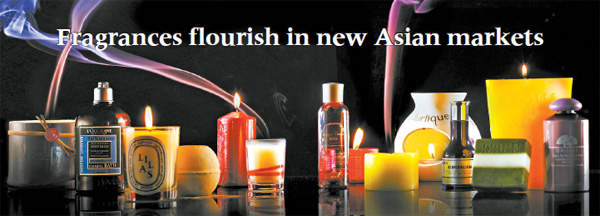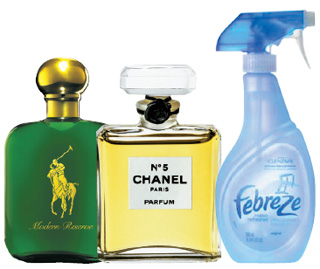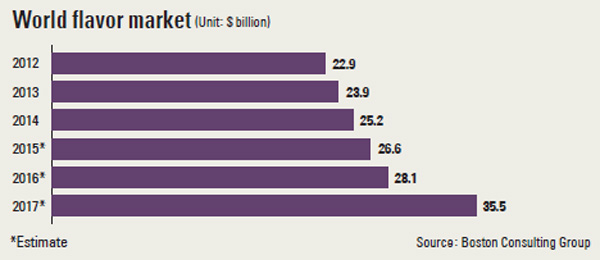Fragrances flourish in new Asian markets

This is because a growing number of consumers think spending money on pleasant smells is necessary rather than extravagant. Spraying air freshener products like Febreze and lighting aromatic candles have become routine. Growing consumer demand for relaxing scents from candles and diffusers as a form of stress relief has also contributed to the rise of the fragrance market.
As demand grows, sales of flavors - the raw materials used to make fragrances - are also getting a boost.
Flavors are expected to have a bright future because they are used to make a wide variety of goods - food, beverages, perfumes and detergents - and do not require complicated chemical technology.
According to the Boston Consulting Group, the world’s flavor market is estimated to be worth about $26.6 billion and will grow to $35.5 billion by 2019. Some analysts even predict the market will be worth $40 billion.
Swiss companies Givaudan and Firmenich are the world’s two largest flavor companies, both founded in 1895. Together they make up about 34 percent of the world’s flavor and fragrance market. Givaudan is famous for developing perfumes for Ralph Lauren, and Firmenich is well-known because one of the company’s researchers Leopold Ruzicka received the Nobel Prize in Chemistry in 1939, and because it was one of the first companies to commercialize strawberry and citrus scents.
The world’s five largest flavor and fragrance companies, from Switzerland, the United States and Japan, make up more than 60 percent of the market, and a few Chinese companies have also recently emerged as new players.
Huabao International Holdings, China’s largest fragrance developer by market capitalization, held 1.7 percent of the world’s flavor market in 2013, making it the world’s 12th-largest fragrance developer. The Chinese economy’s rapid growth has led to greater demand for artificial flavors and scents, which has helped the relatively small company.
As Chinese consumers started spending more on fragrances, Huabao founder and CEO Chu Lam-yiu became one of the richest businesswomen in China. According to Hurun Research Institute, a Chinese version of Forbes, Chu was estimated to own assets of about 2.9 trillion won ($2.6 billion) in 2014, making her the eighth-richest woman in the country.
The Korean fragrance market is also growing quickly along with the international trend.
According to the Ministry of Trade, Industry and Energy, the local fragrance market for deodorants and air fresheners was worth about 2.5 trillion won in 2013 and is estimated to grow an average of 10 percent per year.

“Europe, which has a long history in precise chemical industries, is still strong at processing and refining raw materials like fruits and herbs to create scents,” said Jeon Seung-bae, a director at the Korea Flavor and Fragrance Association. “Korea doesn’t have as wide a variety of raw materials as China, but I believe Korea can win over those competitors with more sophisticated material processing technologies.”
Globally, Febreze, a deodorant spray from P&G, is the leader in its field. First released in the 1990s in the United States, the spray started a culture of deodorizing in Korea. People even spray it on their suits after leaving an office get-together at a barbecue restaurant. The most popular Febreze Air Freshener product reached $1 billion in sales in 2011.
The scented candle market is another area that has seen sharp growth. One of the biggest successes is U.S.-based Yankee Candle, which makes more than 1 trillion won in sales while earning operating profit in the 20 percent range. The company is the No. 1 player in the U.S. candle market, taking 47 percent of the market share. The company’s operating profit is quadruple that of Korea’s 100 largest listed companies, which make an average of 5.3 percent profit.
With the market growth, perfumiers who develop new scents are cashing in and some are as highly accredited as star fashion designers.
According to Asahi Shimbun Globe, major fragrance companies give out a bonus of from 3.6 billion won to 6 billion won to the perfume creator if they win international fragrance competitions. Because a hit perfume brings in billions of dollars, the companies are willing to give big rewards.
Fragrance is a value-added industry, with production cost as low as 20 percent of the actual sales price. That is why so many new scents are released each year, with many fragrance makers dreaming that their scent will become the next Chanel No. 5.

Analysts say the success of fragrances in Korea will also be boosted by the popularity of deodorizing products among the aging consumers and due to the increasing popularity of having pets.
“As more people raise cats and dogs inside their houses, more customers are looking for scented candles to try to eliminate the pet odor,” said a sales person from Yankee Candle’s Dogok-dong branch in southern Seoul.
Some retail chains in Korea market their products by having fragrances products inside their stores, as various researches say the sense of smell can lead store visitors into impulsive purchases by directly prompting the human brain’s command system.
In the United States, people are even experimenting with blind dates by scent, in which participants get to pick their match based only on their sent, without looking at each other.
BY SUH YOU-JIN [kim.jiyoon@joongang.co.kr]










with the Korea JoongAng Daily
To write comments, please log in to one of the accounts.
Standards Board Policy (0/250자)